Background
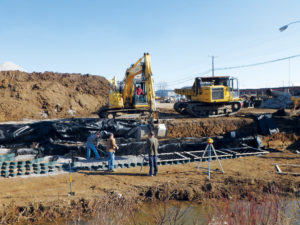
Spy Run Creek in Fort Wayne, Ind., is a 10-mile watercourse that drains several square miles on the northwest side of Fort Wayne. Spy Run Creek empties into the St. Mary’s River in downtown Fort Wayne, just upstream from its confluence with the St. Joseph River. The St. Mary’s and the St. Joseph rivers join to create the Maumee River, which flows northeasterly into northwestern Ohio and Lake Erie.
The main focus of the project was to reduce flooding in the Upper Spy Run Watershed and, more specifically, the Interstate Business Park located between Interstate 69 and Coliseum Boulevard.
Channel improvements to Spy Run Creek had previously been completed between Production Drive and Coliseum Boulevard in downtown Fort Wayne. The businesses to the west and north of the creek in this area were the primary properties affected by the frequent flooding. In 2013, buildings on both the east and west sides of Spy Run Creek in the Interstate Business Park experienced significant flooding.
In general, Spy Run Creek is prone to flash flooding throughout the watershed and, specifically, in this area. It is not uncommon for floodwaters to reach interior streets within the business park.
The original banks of the creek were heavily overgrown and difficult to maintain. Small to moderately sized trees grew out of the banks as well as brush and other undergrowth. In most places along the project area, the creek could not be accessed from the top of the bank because of the dense growth and close proximity to development. This heavy growth likely contributed to the flash flooding in this length of the creek simply from the cross-sectional channel area that was taken up by it.
Velocities in the creek were also high during flooding events. In one instance, gravel was washed out from underneath a box truck, except for directly beneath the wheels, to a depth of more than 6in. Also, due to the velocity, several areas of bank erosion existed along the west bank of the creek, including an area near a large utility pole. The bank was just a few feet away from washing away from the pole base at the time construction commenced.
Recommendations for additional flood storage
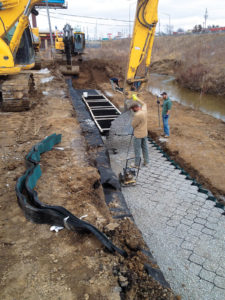
Initially, in 2005, Fort Wayne City Utilities Engineering and Christopher B. Burke Engineering LLC began an analysis of the Spy Run Watershed to determine what improvements should be made in the Upper Spy Run Watershed. The report looked at a number of options including acquisition of affected properties, regional detention, and streambank modifications and restoration.
Analysis of the characteristics of the stream helped the project team decide that providing additional flood storage would be the ideal option to reduce the instances and impact of flooding in this section of the stream. The final recommendation for providing storage resulted in a two-phase project.
Phase 1 of the project included providing regional detention through the construction of three offline overflow ponds upstream of the business park in an undeveloped area near Interstate 69 and Lima Road. The construction of these ponds also allowed for a significant commercial development on a previously underutilized, undeveloped property adjacent to an interstate interchange. These ponds provide additional offline storage volume within the watershed. The inlets to the ponds are set at the 10-year storm stream elevation and the outlets are set to allow the outflow equivalent of a
two-year storm. The ponds act as both detention and flood-storage basins.
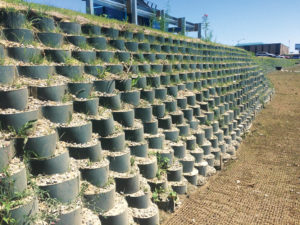
Phase 2 of the project included providing a two-stage channel for the length of Spy Run Creek between Production Road and Coliseum Boulevard. This would allow for additional storage within the channel of the stream and provide opportunities to mitigate plant loss and wetlands impacts within the channel.
Two-stage channel
The two-stage channel concept is a widening of the existing channel beginning at 1ft above the normal water elevation. In the case of Spy Run Creek, ample width existed from the existing top of bank to the drainage easement limits to allow for several thousand cubic feet of additional flood storage above the normal water elevation.
Cellular confinement system for bank protection
As noted, there was ample width from the existing top of bank to the drainage easement limits to construct a two-stage channel; however, traditional earthen slopes were not used.
The primary reason for not using a traditional earthen, vegetated slope is loss of flood-storage volume. A 3:1 slope or flatter is recommended for use of native material and, due to high stream velocities during flood events, erosion of the banks would have occurred.
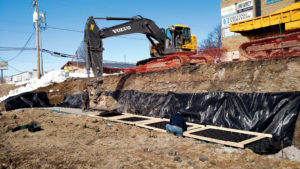
In lieu of the traditional earthen banks, a plastic cellular confinement system was installed. This material resembles a honeycomb laid flat and backfilled with material to hold it in place.
There were two critical reasons for choosing to use the cellular confinement system:
- Use of the cellular confinement system allowed for a steep (0.5:1) slope of bank, which allowed for additional flood storage.
- The cellular confinement system also has a relatively small horizontal footprint. For this installation, horizontal reinforcement, such as geotextile anchoring, was not required. Therefore, the confinement material is simply laid out, layer by layer, and backfilled to the proposed top-of-bank elevation.
The face cell of the confinement material was filled with a mix of gravel and topsoil and then seeded with a native plant mixture in order to allow vegetation to cover the face of the wall. The two-stage channel was also planted with native vegetation.
Flood reduction
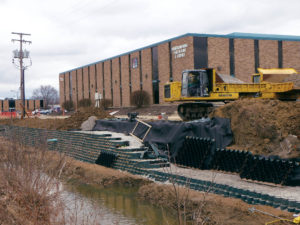
The goal of this project was to provide for additional flood storage and ultimately reduce flooding on Spy Run Creek within the Interstate Business Park. The project has been successful in achieving that goal.
Upon completion of the installation of the cellular confinement system in 2015, Fort Wayne experienced one of the wettest summers on record. While a large portion of the city experienced flooding, the two-stage channel and confinement system was inundated but withstood its first test.
With the exception of a small area of washout, the system performed as expected. While there was flooding in the business park, it was not a result of Spy Run Creek overflowing its banks, but rather due to the limitations of the stormwater system within the park. To date, no floodwater has entered or threatened the adjacent properties and buildings.
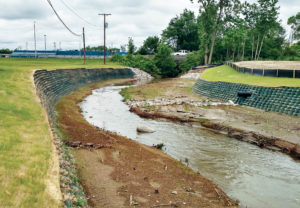
In October 2015, Fort Wayne City Utilities began developing and submitting a Letter of Map Revision (LOMR) to the Federal Emergency Management Agency (FEMA) to provide hydraulic modeling and supporting data to reflect these projects.
Currently, FEMA is reviewing the submitted data, but it is anticipated that the LOMR will be granted. Based on the submitted information, the 100-year flood elevation of Spy Run Creek is expected to drop between 0.0ft to more than 2.5ft between Coliseum Boulevard and Interstate 69.
While there are no guarantees that significant flooding will not occur on Spy Run Creek, by providing additional flood storage in the Upper Spy Run Creek Watershed, Fort Wayne City Utilities is taking measures to help prevent or lessen the impacts of significant storms in the Interstate Business Park while helping business owners protect their properties.
Anne Marie Smrchek is engineering manager for the city of Fort Wayne, Ind.
Jim Blazek is vice president and general manager of D2 Land & Water Resource Inc., based in Indianapolis, Ind.
 TEXTILES.ORG
TEXTILES.ORG


